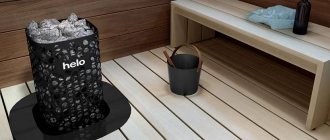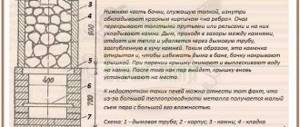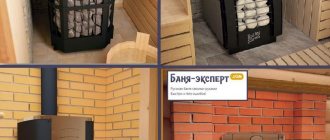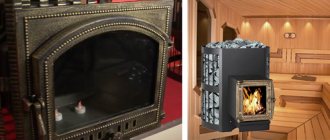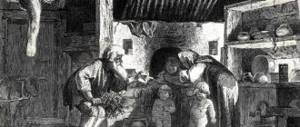Angara stove 2012 - the ideal stove for a Russian bath
If you are a lover of the Russian bath and are looking for a reliable and durable wood-burning stove for it, we recommend you the Angara 2012 stove, which has proven itself excellent over the past few years.
In this article we will talk in detail about all the features that made the TMF Angara 2012 stove so popular among connoisseurs of a real Russian bath. The Angara 2012 sauna stove series includes products of various modifications and different capacities (more details about the modifications can be found at this link), designed for steam rooms with a volume of up to 18 m3 (find out how to correctly calculate the volume of a steam room).
All stoves from the TMF Angara 2012 series are wood-burning and are designed for the “Russian bath” mode, which means that they are equipped with a closed heater and heat the room no higher than 60–70 °C, providing the much-desired light steam.
Now let’s take a closer look at how this can be achieved.
Sauna stove with built-in heat exchanger
Autumn is in full swing, and the “Indian summer” has been replaced by cold and rain. In this weather, I wanted to go to the bathhouse more than ever, I wish I could warm up thoroughly and take a steam bath with a birch broom, but bad luck - there is still no end in sight for the completion of construction. Well, it’s okay, we should be able to handle it by winter, so the stove has already been purchased and will soon be ready to undergo the first tests. But first things first.
Angara 2012 “terracotta”
Many people know firsthand that choosing a stove for a bath is not an easy task; there are many points that need to be put together. This means compactness, reliability, convenience, cost-effectiveness, efficiency, and with all this, it must correspond to the characteristics of a Russian bath, be beautiful and inexpensive.
When choosing a bath heating device, quite a few criteria are taken into account, but we will not focus on this, because everyone has a different approach to this matter, and there are more than enough articles on choosing stoves. I will only name those characteristics that were key for me - compactness, an external fuel channel, the presence of a heat exchanger, proximity to the conditions of a Russian steam room and the use of firewood as fuel. All these features come together in the Hangar 2012 model presented below from.
1
I’ll say right away that I had no initial predisposition to any particular company; I considered all the options presented in our city. Moreover, while looking for a suitable model for myself, I came to the conclusion that inexpensive stoves from different manufacturers are not particularly different from each other. Maybe I would have bought another device, but time was running out, so I chose what I chose.
Description and characteristics
The volume of the steam room for which the stove is designed ranges from 8 to 18 cubic meters. Just right, considering that mine turned out to be about 12 cubic meters
Main parameters:
Dimensions in mm (WxHxD) - 415 x 900 x 830 Heater type - closed (main) + open Weight of stones - 70 kg Maintenance volume - 0.65 l Volume of remote tank - 42-80 l Length of firewood - 500 mm Weight - 58 kg
This model replaced the old one in 2012, and therefore a digital designation was added to its name. By the way, the simple Angara is still in production.
The updated stove received several innovations, this of course was reflected in the price - it went up by about 5 thousand rubles.
Let's try to justify the above-mentioned surcharge. The appearance has not undergone any changes, but the internal design has received a number of significant differences.
The most important thing that I would like to highlight is that she has acquired a closed heater. How important this is can be judged by the numerous complaints of steaming enthusiasts about iron stoves that lack this feature. Steam from open stones has different properties and is more suitable for fans of Finnish saunas.
2
A closed bowl for stones, made of high-alloy steel 3 mm thick, is engulfed in fire from all sides during heating, thereby allowing the stones to warm up to a high temperature. To supply water inside the heater, there is a special funnel included in the kit. To reduce infrared radiation and more efficiently use energy from the combustion of wood, open laying of stones is also provided.
As you can see in photo 2, the chimney pipe is located in the center; many consider this location not very good, but I think there is no need to focus on this.
Another design feature is a different placement option for the built-in heat exchanger - it now passes directly through the combustion chamber. Holes for connecting the maintenance are provided on both sides, i.e. pipes for supplying water to the remote tank can be connected either on the right or on the left (also convenient).
3
A stainless steel hot water tank has also already been purchased, all that remains is to connect it correctly. It will be located immediately behind the wall in the washing compartment.
4
The stove with an extended firebox was not chosen in vain; it is supposed to be heated from the dressing room. However, it should be noted here that the truncated shape of the channel is not the most suitable for leading the firebox into the next room. When cutting bricks I had to tinker a lot.
It was not known in advance what kind of stove it would be, so the foundation was made according to all the rules - i.e. durable and reliable. All that remained to be done before installing the Angara was to lay porcelain tiles.
5
The Angara 2012 has modifications with a fire door made of heat-resistant glass, but in order to save money, the simplest option was chosen - it is completely metal. For the same reason, the color of the outer thermal casing was chosen - “terracotta”, as the most budget-friendly one.
6
In a stove of this class, everything is as it should be - at the bottom there is an ash drawer, inside there is a neat combustion chamber with a cast-iron grate. By the way, ordinary firewood will do here; you don’t need to cut it specially for this stove; it’s a small thing, of course, but it’s nice.
7
This is the Angara 2012 oven, time will tell how it will actually perform. I hope that, after all, it will please you more than disappoint you and will last longer than the stated warranty period of three years.
Closed heater
The Angara 2012 stove is intended for a Russian bath and is not suitable for a Finnish sauna precisely because of the closed cylindrical heater located above the firebox and surrounded by a vortex reheating chamber, separating it from the open heater. This improved design helped to achieve redistribution of heat from the burned fuel, primarily in the area of the closed heater. Thanks to this, the stones in it are heated by circular streams of fire up to 600°C quickly and evenly .
To supply water, a funnel with a narrow pipe is used, which delivers water to the very center of the heater. This is where the effect that true connoisseurs of the Russian bath love so much is achieved - the so-called light steam without overdried and overheated air. Such valuable lightness is acquired as steam passes through the entire closed and part of the open heater, during which it is split into even smaller and lighter particles.
A closed heater - together with a small open one - can hold up to 70 kg of stones.
Kamenka
Two heaters - one internal closed , heated on all sides by radiation and convection from the gas-flame flow and the second - open external . Water is fed into a closed heater through a funnel with a check valve, where it evaporates, but the steam from it does not immediately exit into the steam room, but first enters the open heater at high speed, where it is additionally overheated and only then enters the steam room. It is convenient to steam and refresh the broom on the stones of an open heater, as well as evaporate flavors.
| Internal heater volume | 30 l. |
| Mass of stones up to | 45 kg. |
| External heater volume | 10 l. |
| Mass of stones up to | 15 kg. |
Mass of stones
59 kg.
Stoves Termofor-TMF Geyser 2014 Inox with closed heater
The wood-burning stove-heater Geyser 2014 Inox with a closed heater is designed for heating the steam room of a bathhouse and its adjacent rooms, generating steam and heating water. The stove is convenient for individual use in a Russian bath and allows you to get all the comfortable combinations of temperature and air humidity. The recommended mode of moderately intense combustion when the temperature in the bath is set (no more than one and a half hours in a row) and the mode of economical combustion while maintaining the selected temperature.
2 basic models Geyser and Geyser Vitra are commercially produced. These models have common design features and operating principles. The difference between the models lies in the overall dimensions and type of the fuel channel and door. which the oven is equipped with. The oven has several convector colors.
The Geyser Inox stove with a closed heater is made of heat-resistant high-alloy steel, corrosion-resistant (stainless).
Attention! The maximum volume of a heated room is determined from the conditions for ensuring effective convection heat exchange and the standards for the general thermal resistance of enclosing structures according to SNiP 03/23/2003
Recommended capacity of a samovar-type tank for hot water: 55-72 liters, and for a remote tank for hot water: 63 liters.
Attention! Tanks for hot water and a samovar-type heat exchanger are not included in the delivery package.
The heating time of the steam room is from 20 to 100 degrees, provided the steam room is thermally insulated, about 60 minutes.
Design Features
In Geyser stoves, the firebox, flue channels and heaters are made of heat-resistant high-alloy steel with a chromium content of at least 13%. the use of this steel made it possible to reduce the thickness of the firebox walls to 2 mm without compromising its service life. This reduced the mass of the furnace and, as a consequence, its thermal inertness. In the upper part of the firebox (12) there are special gas ducts (9). The design of the Geyser Inox stove with a closed heater implements an effective heat exchange scheme. The stove heater is divided into two stages: the first stage (10) is a closed heater and the second stage (2) is open, which are connected to each other by pipes (11). A metering valve for water supply (7) is installed on the hole for laying stones in the first stage heater. The heating surfaces of the furnace are covered by an external convector (3). The stove is equipped with an external fuel channel (4), allowing it to be fired from the adjacent room. The firebox door is available in two interchangeable versions. A steel door (5) with a self-cooling outer panel and an original design door with a translucent screen made of heat-resistant Schott Robax glass (14). The Geyser Vitra model is equipped with a panoramic fuel channel and a door with a translucent screen (15). The presence of a screen made of heat-resistant glass allows you to visually control the combustion process and simply admire the view of a live fire. The grate (13), made of massive cast iron, is installed in the lower part of the firebox. Under the firebox there is an ash pan with a retractable ash drawer (6). Elements of the furnace that do not bear a large thermal load are made of structural steel. The outer surface of the furnace is covered with heat-resistant heated enamel type KO-868.
Design and operation of the Termofor Geyser 2014 Inox sauna stove with a closed heater
The Geyser stove operates in intensive combustion mode when the temperature in the bath is set, as well as in economical mode, while maintaining the selected temperature. The firebox door, rotating on a hinge, opens to the angle required for convenient and safe loading of fuel. The convector, covering the heating surfaces of the furnace, accelerates the heating of the air in the steam room due to the powerful convection flow it generates. In addition, it screens hard infrared radiation emanating from the hot walls of the firebox, which creates especially soft convection heat in the steam room and serves as protection against accidental touching of the stove during operation. When the furnace is operating, the primary air required for combustion is supplied to the fuel through a loosely closed ash box and grate. The grate allows you to speed up the combustion process and obtain a powerful high-temperature flame at the moment of ignition. It ensures uniform and powerful combustion of wood, which is so necessary for a sauna stove. Secondary air, saturated with oxygen, necessary for afterburning of exhaust gases, is supplied through gas ducts. Through the cracks of the grate, ash and slag fall into the ash box, with which you can easily clean the furnace without interrupting the combustion process. Gaseous combustion products are directed into a chimney pipe with a diameter of 115 mm. The stove's heater, divided into two parts, allows for efficient use of the heated mass of stones. A large mass of stones placed in both sections of the heater ensures temperature stability in the steam room and is a powerful steam generator. The water valve, together with the heaters, is an original system for producing dry and light steam.
Marking of the Geyser 2014 Inox wood-burning sauna stove with a closed heater
The oven is packed in a packaging container. The instruction manual, in a packaging bag, is included in the furnace firebox. There is a label on the front of the stove packaging that contains information about the stove model, weight, design features and date of manufacture.
Operating restrictions for the Geyser Termofor sauna stove
Attention! For industrial premises of categories A, B. in explosion and fire safety in accordance with NPB 105-95 (definition of categories of premises and buildings according to explosion and fire hazard), the use of a furnace is not allowed.
Attention! Substances not listed above are not allowed to be used as fuel.
Attention! It is strictly prohibited to use coal and coal briquettes as fuel.
Attention! It is not allowed to use alcohol-containing products, gasoline, kerosene or other flammable substances for ignition. As well as glossy paper, scraps of chipboard, laminate and hardboard, since when they are burned, harmful gases can be released.
Attention! Do not operate the oven with an empty hot water tank or an unconnected water heating system.
Attention Do not overheat or overheat the oven during operation.
Overheating a furnace means heating the furnace walls to over 700 degrees. In amateur practice, the temperature of a hot part can be determined by color:
dark brown (visible in the dark) - 530-580 degrees
brown-red - 650-730 degrees
dark cherry red - 730 - 770 degrees
cherry - red - 770-800 degrees.
Attention! When the furnace is heated for the first time, industrial oils applied to the metal and light volatile components of silicone enamel emit smoke and odor, which are not released later. Therefore, the first firing of the furnace must be carried out in the open air in compliance with fire safety measures, lasting at least 1 hour, with fuel loaded to half the furnace in intensive combustion mode.
Attention! To avoid damage to the paintwork during the first heating, do not perform mechanical impact on the surface of the oven until it has completely cooled and the paint has completely polymerized.
Stones for the heater of the Termofor Geyser stove
Stones specially intended for this purpose should be placed in the heater. The manufacturer recommends using gabrodiabase, peridotite, soapstone, and jadeite. These volcanic rocks have a beautiful texture and consist of minerals that are resistant to physical and chemical attack and do not contain harmful impurities. They have a greater heat capacity, can withstand large, repeated temperature changes without fear of fire, and when water is supplied to the boiler, they are destroyed and do not crack. The torn, irregular shape of the stones and the difference in their linear sizes ensure maximum filling of the heater and the largest heat transfer area.
Attention! Stones of unknown origin may contain large quantities of harmful sulfur compounds and radionuclides, which make them unsuitable and even dangerous for use in a bathhouse.
Before laying, stones should be washed in running water with a stiff brush. Relatively large stones are placed on the bottom of the heater so that the flattest surfaces of the stones fit as tightly as possible against its metal surfaces. Smaller stones are placed as tightly as possible between larger stones. Stones should not be placed above the upper level of the furnace; they will not be able to warm up to the temperature required for high-quality steam formation.
Fuel
Specially designed to operate efficiently on natural or liquefied gas . As a rule, most gas stoves for baths are country wood-burning units, in which a gas burner was simply pushed into the firebox. There are two differences between this oven and others. The first is that its firebox was immediately designed to burn gas, not wood.
The second difference is that this stove is specially made for leisurely and high-quality preparation of a Russian steam bath. So that the walls of the steam room are warmed up properly, so that the temperature is low, but the humidity is such that it’s deafening. Very few metal stoves are able to not overheat the steam room and maintain high humidity for a long time. And even the lightest superheated steam. This oven can.

